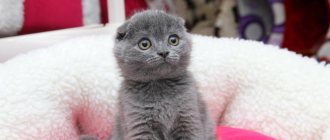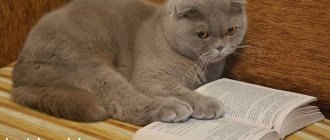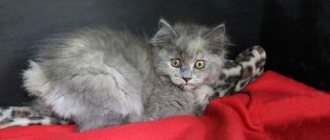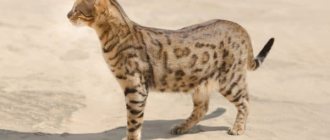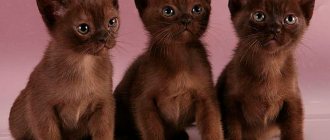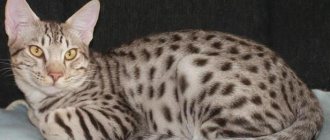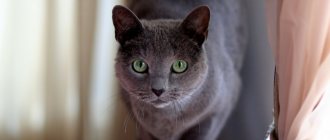- April 17, 2019
- Cats
- Victor Sobolev
The Blue Scottish Fold, otherwise known as the Scottish Fold, is a beautiful breed with a little quirk. Her ears are lowered down, but do not cause any discomfort to the animal. Blue Scottish Fold cats are very beautiful and very popular. As is typical of a true Scot, Scottish Folds are surprisingly calm, intelligent and are able to give their owner irreplaceable comfort in the home. In this article you can learn about the standard of the Scottish Fold cat breed, the characteristics of the animal, its character and possible difficulties.
Breed standard
This is a medium-sized animal, belonging to the short-haired type, with curled ears. Moreover, babies are born with straight ears, but after a few weeks they droop. The coat of a Scottish Fold cat is short and thick, with a pleasant softness to the touch. The body build is dense and powerful. The legs are of medium length, with large pads on the paws. The eye color of blue Scottish Fold cats is usually almond-shaped. In kittens they may be a different color, which will change over time. The weight of the pet varies from 3 to 6 kilograms, depending on gender. The size of the Scottish Fold cat is approximately 28-30 cm.
Features of marble color, types
The fur of a Scottish marbled cat looks very impressive. There are several general features of the drawing:
- the presence of dark lines on a light background;
- bright arrows coming from the outer and inner corners of the eye;
- the letter "M" on the forehead;
- hairs at the base are light, darkening towards the tips;
- striped tail (wide rings);
- bright stripes on the neck and chest, framing them like a necklace;
- spots, circles on the sides, located symmetrically relative to the line of the spine.
Each individual type has its own color scheme. Black marble (another name is brown) has a warm beige background, and a dark brown pattern, almost black in places. The undercoat is light beige. The animal's eyes are a rich amber color, and its paw pads are black.
Marble on silver differs from the one described above in the color of the undercoat. On a light, silver background, dark spots look like a bright contrast. The color of a cat's eyes varies from amber to honey. There are individuals with green irises. Paw pads are black.
Blue marble has a bluish-grayish primary coat color. The peculiarity of the type is that the pattern is not as pronounced as that of the black or silver type. It's slightly blurry. The iris is amber. The color of the paw pads is grey.
If an animal has the pheomelanin gene, then the predominant coat color is red. These individuals include red marble. Red marbled kittens have a rich yellowish base color of fur, on which there is an orange pattern. The pigment is also present in the iris; it is yellowish-brown. The pads on the paws are soft pink.
The tortoiseshell species is especially interesting. It can only be seen in females. The organism of individuals combines two pigments: black and red. As a result, the animal looks like black marble, in which there are chaotically scattered red spots. Such “sunny” inclusions do not always make the pet attractive. You can see a spot on one of the toes. Tortoiseshell cats, respectively, give birth to black or red Scottish marbled offspring, so this species is a favorite of “cat lovers.”
Marble on gold is considered a rare color. The sheen of noble metal is provided by the undercoat. The drawing amazingly combines black and apricot colors. The iris of the eyes is green, the skin of the paw pads is black.
The chocolate shade contains different shades of brown. This is a very beautiful pet with amber eyes and brown paw pads. Breeders approach with particular scrupulousness the selection of a pair of marbled tabby cats, so that as a result amazing offspring are born.
Description of the blue Scottish fold cat
As a rule, it is believed that there are practically no incidents with these beautiful creatures. By nature, blue Scottish Fold cats are quite calm and affectionate. As children, they quickly get used to a new place and household thanks to their natural friendliness. They love their owners so much that they are ready to follow them on their heels, while doing so unobtrusively. The Scots have a stable and balanced psyche. They get along well not only with children and animals, but even with strangers. Scottish Fold cats have normal health and cleanliness.
As with any other living beings, there are some problems with the Scots. This usually occurs when the cat is still young and full of energy. Young Scottish Folds are very active and can run around rooms for hours. But adult individuals have a phlegmatic disposition and would rather sit on their owner’s lap than play and run around.
Character and habits
It’s great that Scottish Fold babies easily get used to using the toilet and quickly understand what a scratching post is for. These kittens have a cheerful and mischievous disposition. In addition, they are very smart, quick-witted and understanding pets.
Scottish Folds easily settle into a new place and intuitively pick up on the mood of the breadwinner, even when he is far away. These cats have natural sensitivity and strive to please and console when their owners are sad. They have a sentimental and tender soul.
Scottish Folds are completely good-natured and not vindictive, but they cannot stand being treated harshly and rudely, or being yelled at. Owners do not want to shout at their cats too much, otherwise they may become timid and weak-willed.
Scottish Folds are excellent companions for not very young and elderly owners, as they do not tend to jump around and make a mess. The Scot loves to sit close to the owner and immerse himself in contemplation of his activities.
Representatives of this breed are unobtrusive. If they need something, they will not yell, but will speak quietly. These cats are easy to train. They easily learn the rules established by the owner in the home.
If an animal is trained from infancy, then as it matures it will be able to remember that it is forbidden to climb onto beds and other forbidden points. The uniqueness of the habits of Scottish Folds is that they like to stand on their hind legs, as if interested in something.
Such pets are unpretentious in everyday matters, do not hesitate if they find themselves in an unknown place, and simply relate to traveling on any type of transport.
Scottish fold cost
The price of a kitten depends on what the future owners plan to get a pet for. For people for whom it is fundamentally important to get a purebred show-class kitten for its subsequent participation in exhibitions, the cost will be at least 50 thousand. If they buy a baby just for the soul and its origin is not so important for the family, then it is quite possible to purchase an animal for between 10-30 thousand rubles. The Blue Scottish Fold cat is a fairly common breed. You can buy it in almost any city.
Blue Scottish Fold cat: care and maintenance features
The little Scottish Fold is a real livelier, bursting with energy. When a new family member arrives, you will need to buy the following supplies for his comfortable living in the house:
- two bowls - for food and drink;
- toys - to distract the baby’s attention and not play with him with his hands;
- scratching post;
- combing brush;
- tray;
- basket or sleeping mat.
Before the kitten arrives, you should remove all objects that are dangerous to it: sockets, wires and small things that it could accidentally swallow.
The house must be clean so that the little fragile creature does not get sick.
Keeping a blue Scottish Fold cat will cost owners no more than any other breed.
It's easy to care for. To keep the fur looking neat, it is enough to brush your pet two to three times a week. During the molting period, the procedure is carried out more often.
Ears, eyes and nose should always be clean. If any discharge appears, it should be removed immediately using a cotton pad soaked in water. You need to bathe your cat no more than once every six months.
To the peculiarities of caring for a blue Scottish fold cat, we can add that these creatures are sometimes susceptible to diseases of the joints, eyes and skin. For this reason, you need to closely monitor the animal.
Nutrition
An important aspect of caring for Scottish Folds is food. Nutrition should be regular and balanced so that the pet is always strong. The best option is a harmonious diet based on natural ingredients.
You can also choose good bagged food. Experts and nurseries recommend a varied diet that contains both natural ingredients and cat food. You should always remember to drink regularly.
The water in the bowl should be renewed daily, no matter how much you drink. It is normal for adults to eat 2-3 times a day. You should not change the types of food frequently, so as not to get a stomach ache.
It should be remembered that cats are contraindicated from eating foods with a lot of fat, with vinegar and salt, fried foods and containing sugar. Seasonings and hot and cold foods should be avoided.
Good for Scottish Folds:
- lean meat;
- fish;
- milk;
- cottage cheese.
Vegetable ingredients, fresh and boiled, and all sorts of cereals are needed.
It is not advisable to give:
- eggplant;
- tomatoes;
- onion;
- garlic.
What should you teach your cat?
All pets must be trained to a certain discipline. A cat is not a dog, and it is unlikely that it will unquestioningly follow commands to please its owner. But even such an independent and freedom-loving creature must know the norms of behavior - what can be done and what cannot be done.
Thanks to their high intelligence and quick wit, blue Scottish Fold cats grasp everything literally on the fly, and raising an exemplary pet who will fill life with only joyful moments will not be difficult.
So, what should a domestic cat know and be able to do?
Photo gallery
Photo 1. Gray fold-eared cat
Photo 2. Black fold cat
Photo 3. The ginger cat in the photo looks at the camera
Sharpen your claws only on a scratching post
Claws are an important attribute of any cat. With their help, the animal climbs trees and other surfaces, and also uses them as a means of defense. Sharpening claws, doing a kind of manicure, is a natural need for a pet. Unknowingly, cats begin to tear up everything that gets in their way: furniture, carpets, wallpaper. To avoid this, you need to accustom your pet to order. Every time a cat starts sharpening its claws in an inappropriate place, immediately pick up the animal and bring it to the scratching post. This needs to be repeated several times. Gradually, the animal learns to sharpen its claws where it is needed.
Signs and superstitions
Snow-white cats, perhaps, do not have as many conjectures and prejudices as black cats have. All signs and superstitions about white cats are positive:
- A stray cat with white fur brings good news and change.
- Such a cat is able to protect the house from the evil eye and all evil spirits.
- In some countries, a white cat is considered a mascot. People keep such animals in their homes because they believe that they bring good luck and prosperity.
- Girls who want you to get married as soon as possible should place 7 snow-white kittens in good hands.
- Women are advised to keep a cat with different colored eyes at home if she wants to remain attractive to men.
- If a white cat gets in the way of the newlyweds, they will have a happy and long life together.
- If a white cat crosses the road, you should make a wish.
- Snow-white murki collect negative energy, relieve stress, and guarantee success in any endeavor.
Such animals balance the psyche, normalize the functioning of internal organs, enhance brain activity, and eliminate depression. At least that's what scientists say.
Pet health
In general, cats of this breed have good health, but are sometimes susceptible to certain diseases. Often, pets suffer due to improper mating when Scottish Folds are mated with each other, which is absolutely forbidden to do. The list of common diseases includes:
- entropion of the eyelid;
- allergy;
- deafness.
In addition to the above diseases, Scots in adulthood have problems with the digestive tract and the functioning of the cardiovascular system. To avoid them, you need to monitor your pet’s condition and take him to the veterinarian more often.
What to feed?
To keep your pet happy and healthy, you need to carefully monitor its diet. If the owner plans to feed the cat natural food, then his diet should include the following products:
- meat (beef, turkey, veal);
- boneless fish;
- offal (boiled);
- vegetables;
- eggs.
It is not recommended to feed cats raw, unprocessed meat to avoid infection with helminths. Also, do not give your pet milk. It is useful only for small kittens, but not for adult animals.
Products prohibited for cats include:
- sweets;
- alcohol;
- fatty and fried foods;
- smoked meats
Such food is not only not healthy for the animal, but can also have a detrimental effect on its health and body function.
If the owner decides to feed the pet prepared food, then preference should be given to well-known premium companies, such as Royal Canin or Purina. Scottish Folds happily eat both wet and dry food.
Your cat should always have a bowl of clean, fresh water.
What to name a Scottish kitten
Many new owners of plush kittens prefer to follow the beaten path and give their pets well-known nicknames: Barsik, Murzik, Vaska. But for open-minded cat lovers, choosing a name for a boy or girl is a great way to show creativity and imagination.
What nickname can you come up with for your pet so that it is associated with Scotland? This is not difficult, because the history and culture of this country are known throughout the world. Kilt, bagpipes, whiskey, tartan - this is not a complete list of words that make us think of distant Scotland.
You can rack your brain and come up with a name based on the suggested words. But most often male kittens are named Scott (Scotty), Shot (Shotti), Valli, Rob, Roy, Baxter, Archie and even Holmes or Watson. The girls are called Foxy, Orange, Athena, Shakira, Martha, Chessie, Shaddy.
Difficulties with Scottish Folds
Scottish Folds are peaceful and affectionate creatures. They love their owner and all family members. There are no particular difficulties with keeping Scottish cats. In childhood, kittens are overly active and can cause some trouble for household members, but with age, the playful baby turns into an important and phlegmatic cat. Fold-eared cats are perfect for families with children and for retirees, but they definitely won’t fit into the environment of people who lead an active lifestyle. Scots shed actively several times a year, and during this period you will have to clean more often. Another problem with keeping a blue fold cat is its insatiable appetite. Especially in castrated and neutered animals. To prevent your pet from gaining excess weight, you need to control your food intake.
In general, turning a blind eye to some difficulties, we can say that the Scottish Fold is a wonderful pet.
Owners' opinion
Owners of Scottish Folds often leave comments about their pets. Most owners speak positively about their favorite plush cats. As a rule, they are balanced, intelligent and beautiful. The Scots are kind to all people and animals. But owners often write about problems associated with this breed. These include high activity of the pet at a young age, disobedience, ignoring family members, damage to furniture and fragile health.
Often, most of the problems that a cat creates are the fault of the owner himself, who did not react in time and did not show the pet how to behave correctly. When it comes to health, you need to carefully monitor the condition of the animal and not leave the situation to chance.
Scottish Folds are the smartest and most graceful creatures that, with proper training and care, will be excellent pets.
Breeds of long-haired blue-eyed cats
- Maine Coon;
- Persian;
- British and Scottish Longhair;
- Turkish van;
- angora;
- Javanese;
- balinese;
- Norwegian forest;
- Neva Masquerade.
Shorthair
List of cats with short hair:
- British;
- Scottish;
- Manx;
- exotic;
- Cornish Rex;
- oriental;
- Bengal;
- Himalayan;
- Anatolian;
- Russian white;
- foreign white
Bald
The white Sphynx has no fur. His skin is light pink, almost white, and his eyes are blue. Animals need careful care. They feel comfortable only next to their beloved owner.
